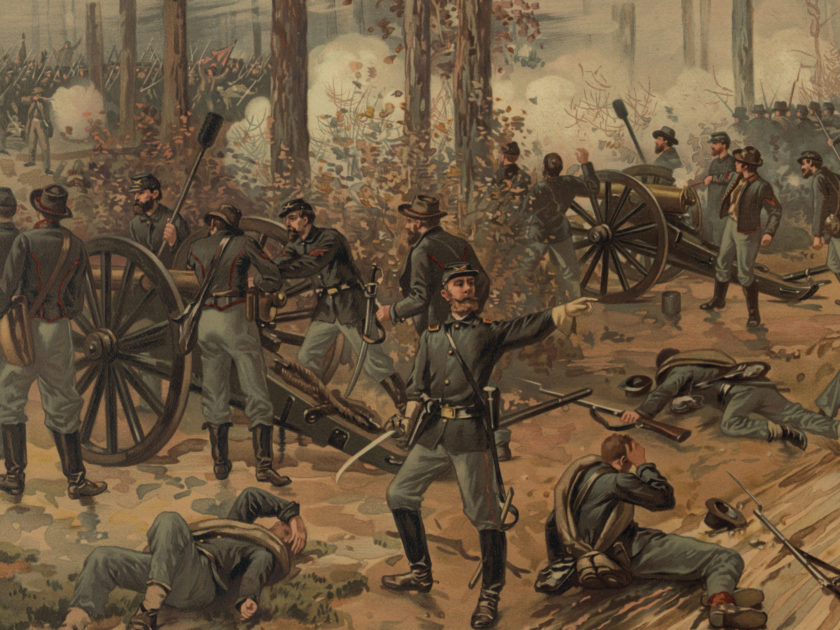Port Hudson: Taken from the Body of a Confederate
One day in mid-1863, a Confederate soldier died—one of many who fell in defense of Port Hudson, La., the fortress city along the Mississippi River. The soldier carried a photograph of a woman holding an infant, likely his wife and child.
Where he fell and his name are lost in time.
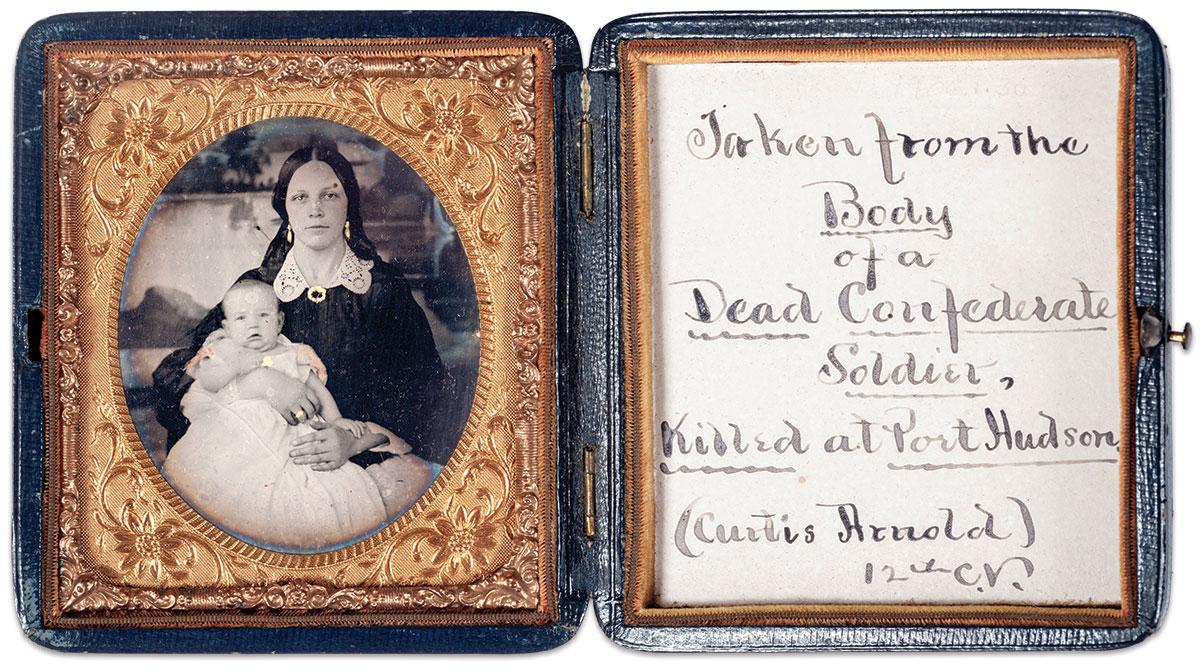
Union soldier Curtis S. Arnold, a peacetime shoemaker, found the body and the photograph. He and his comrades in the 12th Connecticut Infantry had arrived in the vicinity of the Confederate defenses on May 25, 1863. During the weeks that followed, the regiment endured the hardships of trench warfare, and participated in three major assaults against the city.
The first attack occurred on May 27; only two days after the Connecticut Yankees arrived on the scene. According to a history of the 12th, the regiment succeeded in “driving the enemy from its front into their last line of entrenchments, silencing four pieces of artillery, and reaching the parapet of the enemy’s earthworks, when the brigade was withdrawn and replaced by another. The regiment falling back, took position about 150 yards from the earthworks of the enemy.”
It is possible that Arnold discovered the body of the fallen Confederate during this attack, due to the proximity of his regiment to the Confederate lines. No known record of the position of the dead man and the location of the photograph—in his hands, tucked in a coat pocket, jammed into a haversack—has yet been found. If the photo was visible, Arnold might simply have picked it up and carried away. But if it was not visible, he most assuredly rifled the contents of the dead man’s body looking for anything, whether ammunition, food or personal items.
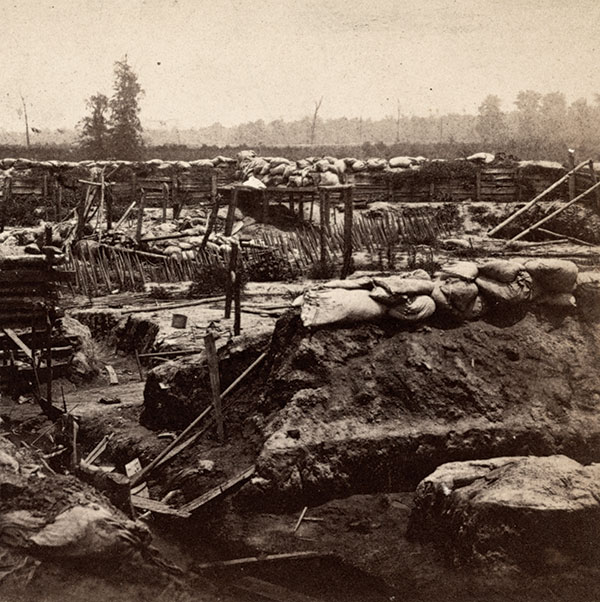
The body might have been discovered during one of the other assaults, on June 10 and 14. At the latter action, Arnold suffered a wound that was not serious enough for him to leave the ranks any longer than it took to patch him up. He and the rest of the 12th remained under fire from sharpshooters until Confederate forces surrendered the city on July 9, 1863.
Arnold’s service at Port Hudson might be considered redemption for an earlier indiscretion. His muster report for the months of March and April 1863 includes a damning reference. During this period, before the regiment arrived at Port Hudson, charges were preferred against him on grounds of “misbehavior before the enemy,” or cowardice.
Two months after the surrender, Arnold fell ill with a cough that turned out to be tuberculosis. By early 1864, his condition had worsened, and he received a furlough to recuperate. On April 27, 1864, he died at home in Portland, Conn. He was about 30. His wife, Nellie, and two daughters survived him. She filed for and received a government pension. Times must have been tough. By 1870, Nellie’s teen daughters had married, and she had fallen into prostitution and moved into a brothel. She died in 1907.
At some point, the photograph passed to the local Grand Army of the Republic post. The image eventually made its way to the collections of the Middlesex County Historical Society in Middletown, Conn., where it remains today.
The Wilderness: Found by W.A.S.
The barebones inscription on the back of this carte de visite creates an aura of mystery. An examination of the image offers possible clues, and an understanding of what happened at The Wilderness provides potentially valuable context.
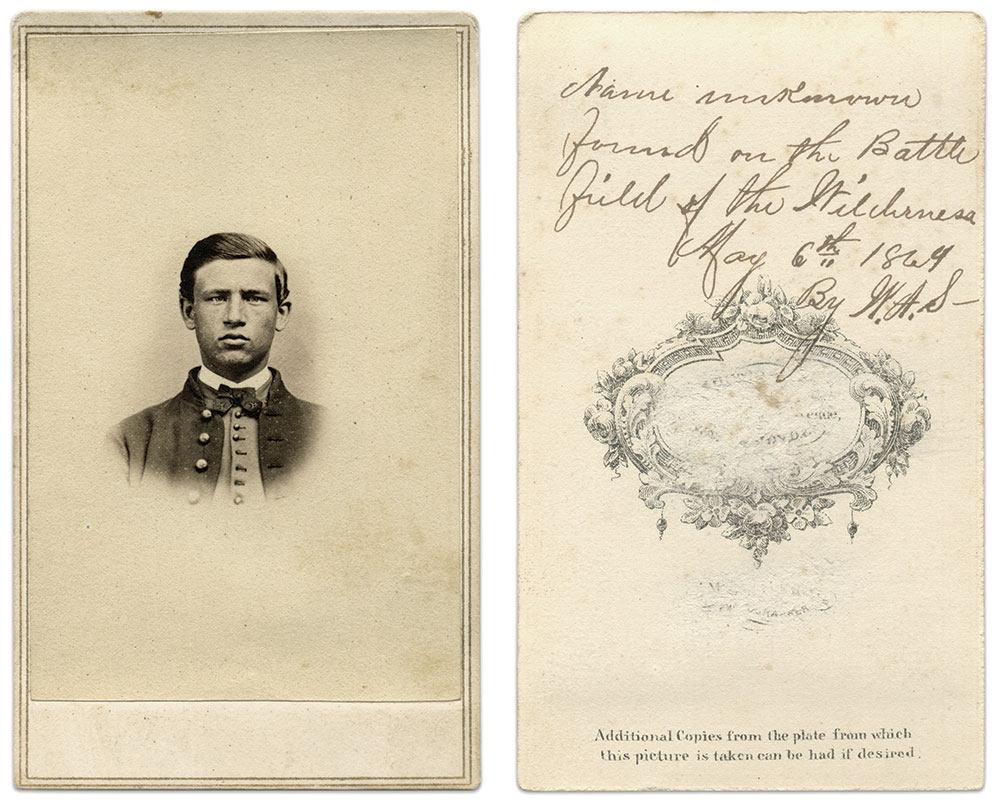
First: the clues.
The relatively pristine condition of the image suggests its discovery soon after it was lost.
On the front, the clean-shaven soldier is a Union enlisted man or non-commissioned officer who probably served in an infantry regiment.
On the back, the period inscription denotes a time and a place, and bears the initials of the individual who found it. The inclusion of the words “Name unknown” establishes that the finder did not know the sitter. The person who found and inscribed it, W.A.S., may have been Reb or Yank, soldier or civilian. The name of the photographer is almost entirely scratched out. This willful erasing of key information is curious. The fragmentary letters that remain indicate the photograph originated in the studio of John Holyland on Pennsylvania Avenue in Washington, D.C.
Now, for the context.
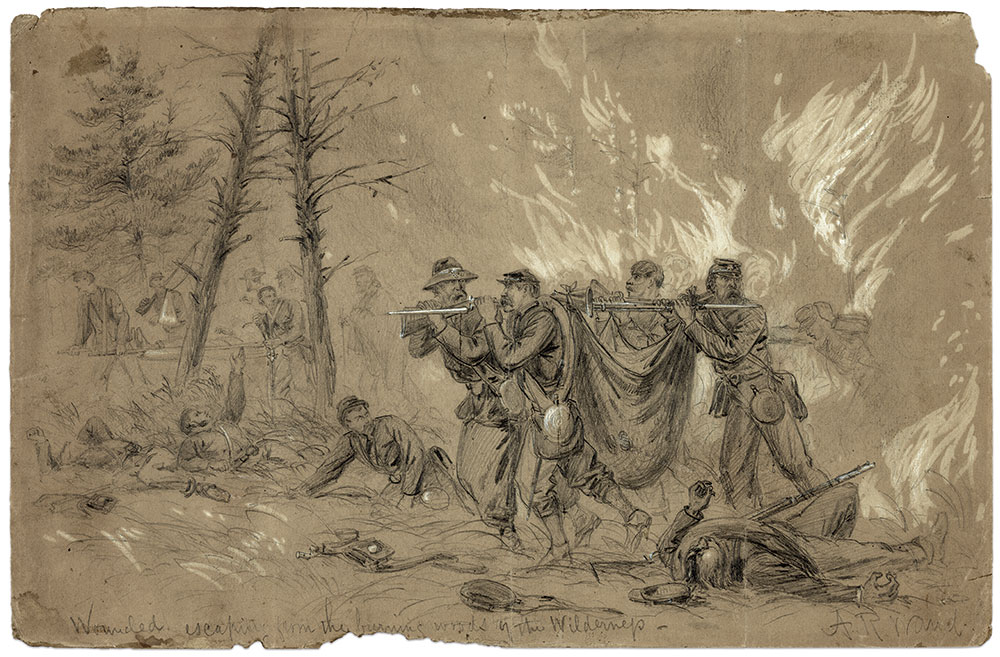
On May 6, 1864, the second day of the Battle of The Wilderness, the opposing sides hit each other with devastating attacks and counterattacks. On the Union side, Maj. Gen, Winfield Scott Hancock’s 2nd Corps attacked a Confederate corps commanded by Lt. Gen. A.P. Hill, and drove it back. Lt. Gen. James Longstreet arrived on the scene and drove back the attackers, and averted a Confederate disaster. Longstreet suffered a wound from friendly fire in the midst of another attack that petered out. Meanwhile, the Union 9th Corps, led by Maj. Gen. Ambrose E. Burnside, suffered a repulse in another attack. At the end of the day, the fight resulted in a tactical draw.
Further sleuthing may lead to the identification of this man.
Shiloh: A Lost Corporal
Almost three weeks after the fighting at Shiloh, a man found this tintype of an infantry corporal on the battlefield. The fact was noted in pencil on the inside of the case: “Shiloh Battle Ground April the 28 1862 Robert J. Richard”

The identity of Richard, what brought him to the battlefield, and his arrival and departure dates are not known. The absence of a military rank or unit identification in his inscription suggests he was a civilian.
If true, Richard had joined the unknown number of men and women who showed up during the days and weeks following the battle, which claimed 24,000 casualties on both sides. The region was unprepared to deal with this magnitude of men, scattered about in field and camp hospitals. Aid came from various sources: by vessel from Cairo, Ill., and other points on the Mississippi River, and by land.
He might have been among the vanguard of volunteer nurses and other medical personnel dispatched by Northern relief organizations, who arrived with food, supplies and care. Members of these organizations, working with the Union army Medical Corps, facilitated the transportation of wounded and sick to regional hospitals for further treatment.
Another possibility is that Richard might have been a family member or friend dispatched on a grim errand to bring home the remains of a loved one, or to locate a missing soldier. An unknown number of these individuals scoured the battlefields in search of information.
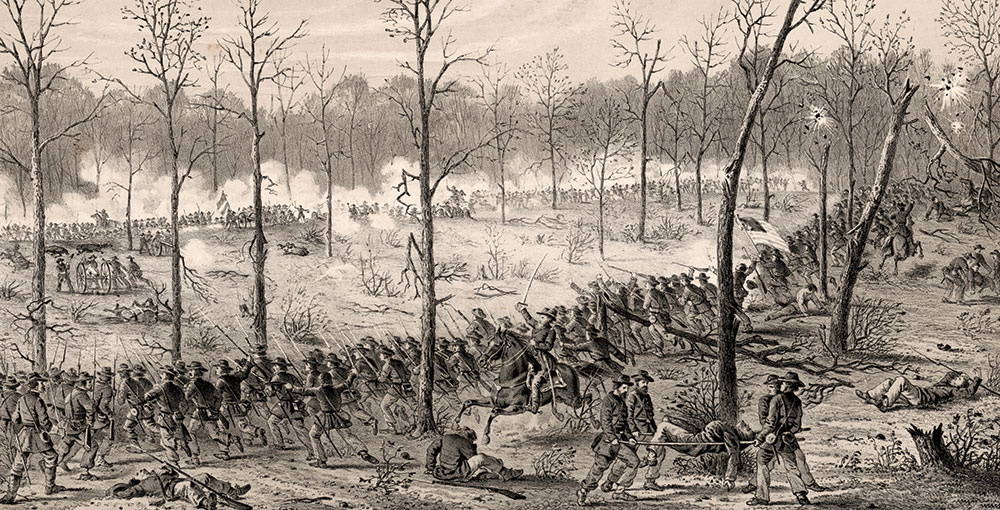
A search of military and genealogical records reveals several potential matches. Two men who went on to military careers after Shiloh are noteworthy. The first individual was a physician who served as an acting assistant surgeon in the Union navy towards the end of the war; the other, an Alabamian, who joined his state’s 54th Infantry in 1863. The surname of both of these men, however, is Richards, not Richard.
Shiloh: Picked Up by a Sergeant Major
The note written in faded pencil on the inside of the case of this ambrotype reveals an unusual provenance: “This picture was picked up on the battle field of Shiloh on Tuesday, 8th April 1862 by Seargt Maj McAllisters Battery (EHC).”

EHC is Edgar H. Cooper, the sergeant major of Battery D of the 1st Illinois Light Artillery. The unit is familiarly known as McAllister’s Battery after its captain, Edward McAllister.
The Vermont-born Cooper left his job as a salesman in April 1861, and joined the 10th Illinois Infantry’s Company K, commanded by McAllister. After the regiment’s three-month enlistment term expired, the company reformed as an artillery battery.
In its first engagement at Fort Donelson in mid-February 1862, the battery received praise for its actions. According to the New York Times, the battery “took position on an eminence, and for four hours their heavy 24-pounders were not silent for a single instant.”

Two months later at Shiloh, the battery again proved its mettle, occupying eight distinct positions during the battle on April 6-7. Maj. Gen. William T. Sherman mentioned the battery in his Memoirs. At one point during the engagement, Sherman scrambled to bring up artillery support in the face of advancing Confederates. He spied a group of Union guns in the rear. “I sent one of my staff to bring them forward, when, by almost providential decree, they proved to be two twenty-four-pound howitzers belonging to McAllister’s battery, and served as well as guns ever could be.”
The praise came at heavy cost. Casualties were high, including McAllister, who remained on the field despite suffering four wounds.
Cooper emerged uninjured. On April 8, as both sides fell back, he found this photograph of a clean-shaven man who leans back in a chair, with a stogie in his mouth, and a cap perched at a rakish angle. Its origin remains a mystery.
Cooper went on to command the battery after McAllister’s injuries and poor health forced his resignation. He eventually advanced in rank to major. He served brief detached stints as Acting Chief of Artillery of the 3rd Division of the 17th Corps, and as commanding officer of Fort Houston in Nashville.
After the war, Cooper lived in various Western cities and towns. He married and started a family that included two children. After the death of his wife, he remarried and fathered a third child. He died in 1914.
Irish Bend: Mabel’s Virtual Adventure
No evidence exists that Mabel Cook ventured any farther than her parent’s home in the Hartford, Conn., suburb of Manchester during the Civil War.
But her likeness decidedly did.
Her brother, Cpl. Aaron Cook Jr., carried this carte de visite of his older sister into battle on April 14, 1863, and recorded the fact on the back. He did not mention the battle by name—Irish Bend—or that it was the first fight for him and his comrades in the 25th Connecticut Infantry.
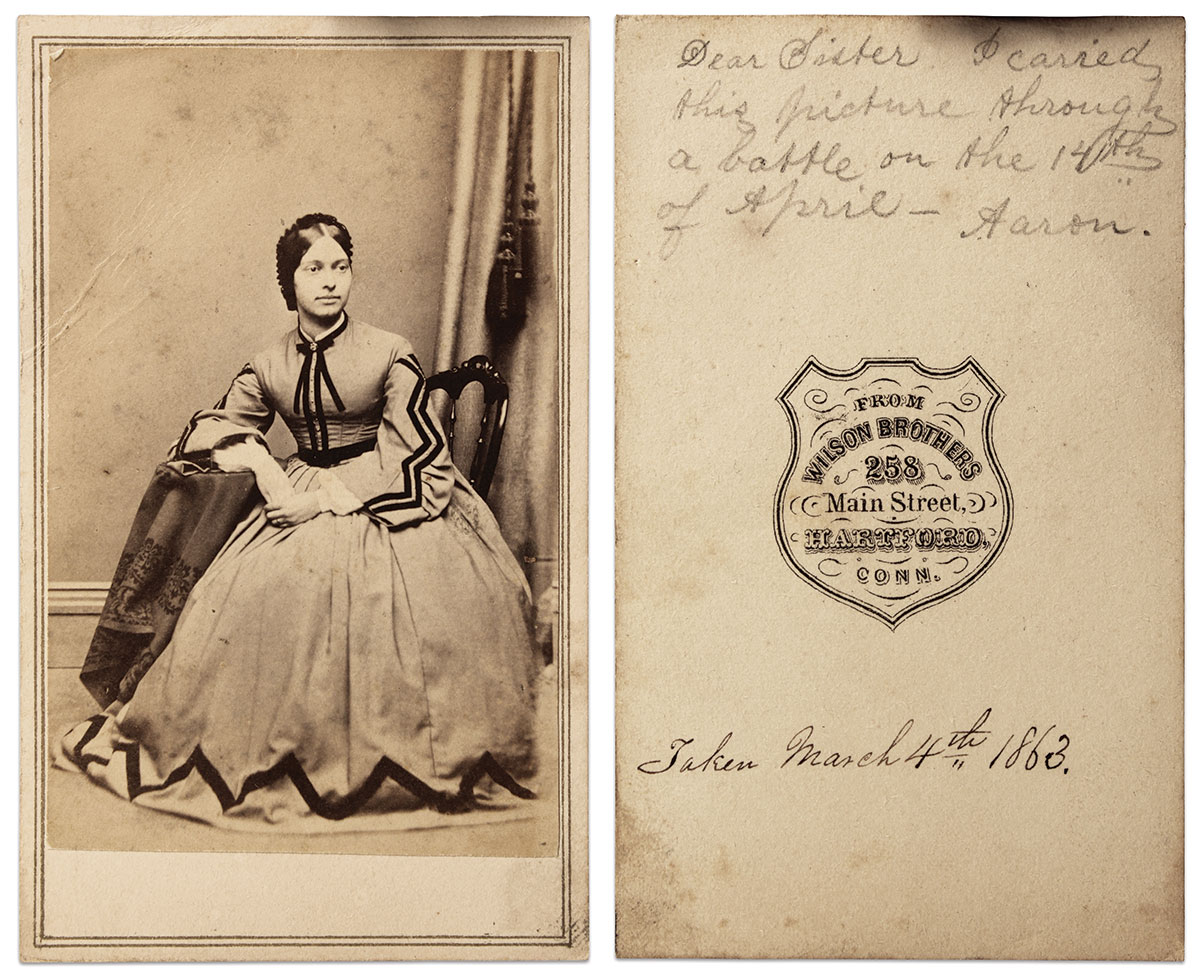
Cook had only been away from home for a few months. In November 1862, the Connecticut Yankees had set out for the South, and landed in Louisiana. While Cook settled into the soldier’s life, his sister posed for this portrait on March 4, 1863, and sent it to her little brother, probably tucked inside a letter.
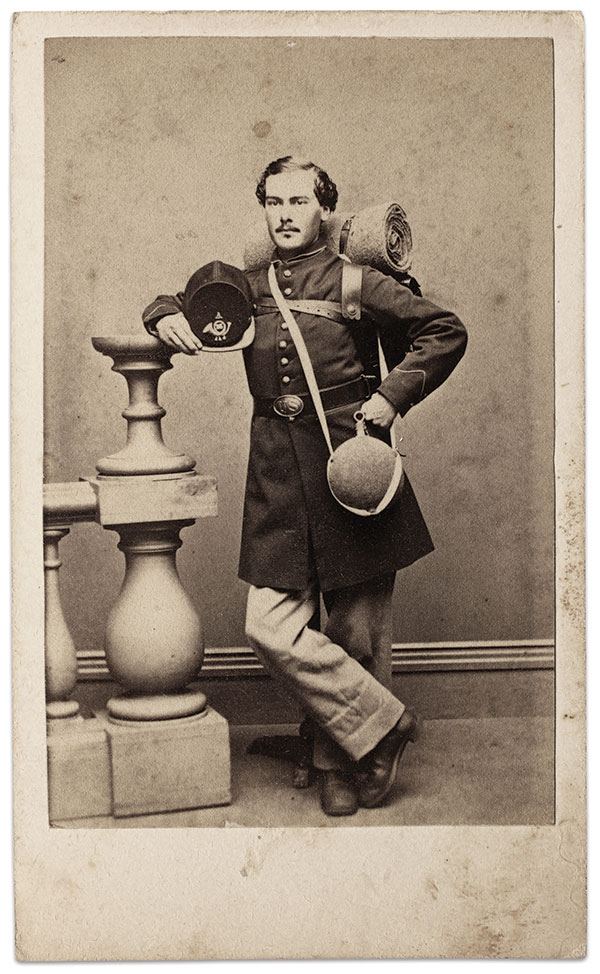
The letter reached Cook before the expedition embarked on March 28. On that day, the 25th joined a division-sized force commanded by Maj. Gen. Nathaniel P. Banks, and marched westward into Louisiana. The portrait survived enemy skirmishes and a trip by boat up Atchafalaya Bayou, which landed at Irish Bend. There, the regiment went into action about 350 muskets strong, and suffered 96 casualties in a Union victory.
Cook survived the battle, became a sergeant, and participated in three more engagements with his regiment before its nine-month enlistment expired in August 1863. He returned safely to Manchester and reunited with Mabel and the rest of his family. He declined an officer’s commission due to poor health, and sat out the rest of the war.
Cook married and raised a family of four children. Active in veteran’s affairs, he likely numbered among those old soldiers whose heart, according to a sketch of the regiment, “swells with just pride as he says to his children and grandchildren, ‘I was a member of the Twenty-fifth Connecticut.’”
Cook lived until 1928, dying at age 85. He outlived his sister, who passed away at age 57 in 1897. She never married.
Petersburg, Va.: Collateral Damage
By Russell Horton, with images from the Wisconsin Veterans Museum
On the morning of June 17, 1864, as the 38th Wisconsin Infantry had its first taste of battle just outside of Petersburg, Va., Maj. Courtland P. Larkin was shot in the lower left abdomen, one of more than 30 men from the 38th wounded that day.
That part of his story is not out of the ordinary.
The path that the Confederate Minié ball took before coming to a halt inside of him, however, is more unique and unusual.
After leaving a Confederate rifle, the ball flew across a field in which, according to a regimental history, “corn was about knee high.” It traveled through “a thick cloud of smoke and dust” that “hid everything, beyond a few paces, from sight.” The shot approached the 20-year-old major as the 38th Wisconsin reached the halfway point between the earthwork and the Rebel forces that it targeted.
The bullet first struck at Larkin’s coat waist pocket, and then passed through two layers of blue wool. As an officer, Larkin most likely wore a privately purchased shirt underneath, so the ball also passed through a layer of cotton or wool, or possibly linen or muslin. The last barrier was Larkin’s own flesh, as it “entered his left side, between the ribs and the hip, and lodged internally.”
Larkin went down hard. He remained on the ground as the 38th bravely charged forward, before being repulsed by the Confederate forces in relatively short order. Only after retreating and regrouping did the men realize that their major was not among them. One soldier recalled seeing him fall in the field, prompting Capt. Charles Carpenter of Company A to courageously venture out and retrieve Larkin’s body. Though feared mortally injured, Larkin survived his wound. He spent time at Douglas Hospital in Washington, D.C., before returning home to recuperate in Milwaukee. The army granted him a discharge on Sept. 2, 1864.
The scar and the Minié ball still lodged inside him, however, were not the only souvenirs that Larkin took away from this traumatic incident. The Confederate bullet pierced six pieces of paper that Larkin carried in his pocket. A handwritten poem and five cartes de visite shared his fate on the field that day, and add depth and context to Larkin’s story. The relative severity of each item’s damage suggests the order in which they lay in Larkin’s pocket on June 17, 1864.
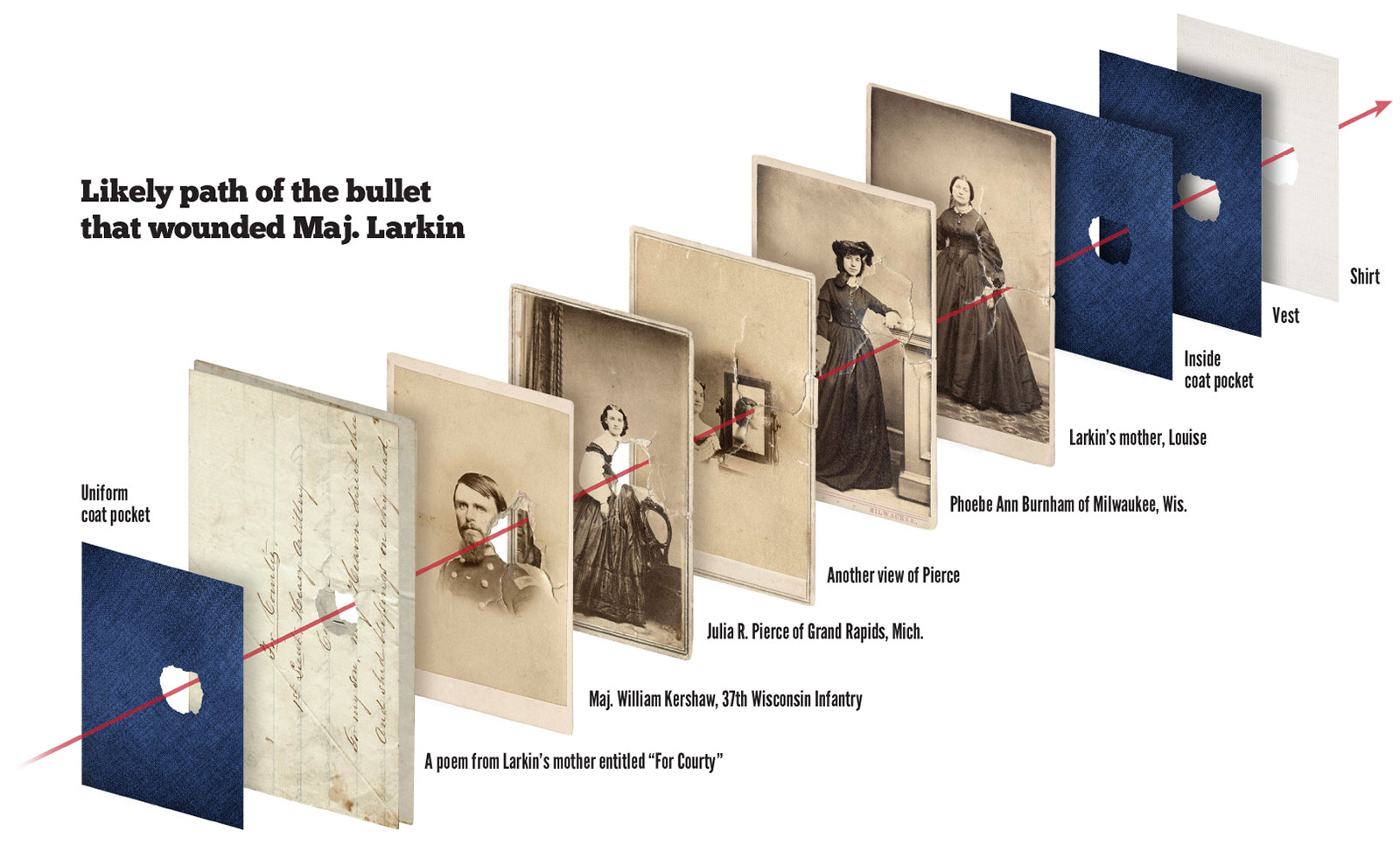 The item bearing the most significant damage, located furthest to the outside of his pocket, is a handwritten poem given to him by his mother. Entitled “For Courty,” possibly her pet name for him, the poem is dated Sept. 13, 1863, less than a week after Larkin accepted a commission as junior first lieutenant with Company B of the 1st Wisconsin Heavy Artillery. The crease lines show that he had carried it in his pocket, and the bullet holes line up perfectly when folded.
The item bearing the most significant damage, located furthest to the outside of his pocket, is a handwritten poem given to him by his mother. Entitled “For Courty,” possibly her pet name for him, the poem is dated Sept. 13, 1863, less than a week after Larkin accepted a commission as junior first lieutenant with Company B of the 1st Wisconsin Heavy Artillery. The crease lines show that he had carried it in his pocket, and the bullet holes line up perfectly when folded.
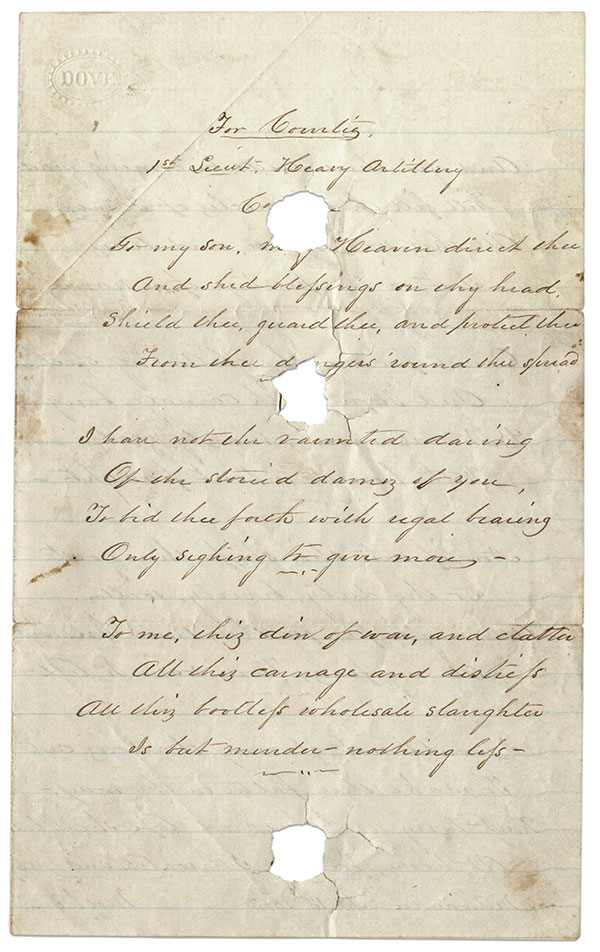
The beautifully crafted poem begins:
“To my son, may Heaven direct thee,
And shed blessings on thy head.
Shield thee, guard thee, and protect thee
From the dangers ‘round thee spread.”
Aside from the outside layer of wool from his coat pocket, this paper absorbed the initial hit from the bullet, and, in a symbolic way, fulfilled her wish to protect him.
Of the five cartes de visite, one of officer William Kershaw most likely took the first hit. The ball tore a piece out of the image, creating a hole through Kershaw’s left ear and jaw on the front, and roughly a third of the photographer’s mark on the back. Taken by N. S. Bennett of Alexandria, Va., possibly in late May 1864, we cannot determine when exactly the 30-year-old army officer gave the carte de visite to Larkin, though they operated in the same area from May 7 through June 17.
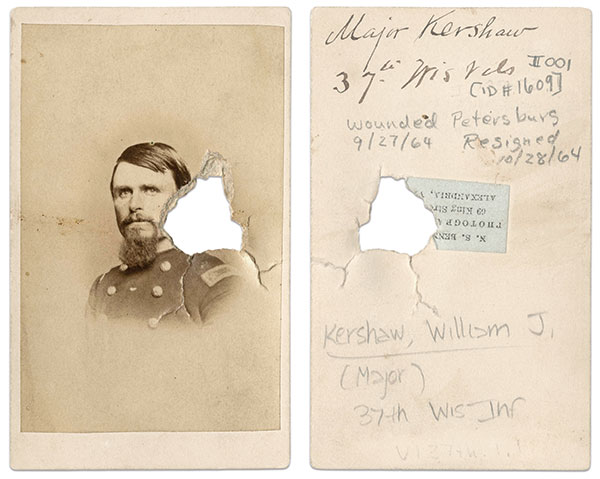
Born in Ireland in 1833, Kershaw immigrated to the U.S. as a young man. He eventually settled in Big Springs, Wis., where he worked as a lawyer and an Indian agent. He met his wife She-qua-na-quo-tok, a Native-American Menominee woman, who later also went by the Anglicized name Mary Corn. Kershaw enlisted into Company E of the 18th Wisconsin Infantry in December 1861; promoted to sergeant major of the regiment in January 1862; and then attained the rank of captain of Company K in March. After seeing action with the 18th at the Battle of Shiloh and the Siege of Corinth, Kershaw resigned his commission in September 1862. He accepted a new appointment with the 37th Wisconsin Infantry in March 1864.
The story of Kershaw’s service in 1864 eerily parallels that of Larkin. Both men simultaneously held the rank of major in Wisconsin regiments: Larkin with the 38th, Kershaw with the 37th. Each man arrived in Washington, D.C., with the first few companies of their regiments in early May 1864, and settled into camp at Arlington Heights. They traveled through Alexandria to White House Landing in late May or early June, and then proceeded to Cold Harbor, before arriving at Petersburg on June 16, 1864. Perhaps most remarkable, though with regiments assigned to different divisions, they became casualties on the same day, June 17, 1864—Larkin wounded in the side and Kershaw through both legs.
While Larkin’s wound led to his discharge, Kershaw returned to active duty in August 1864. One month later, he was arrested and charged with drunkenness while in command of his men in battle, and he resigned his commission in October. He returned to Big Springs and represented the area in both the State Assembly and Senate before moving to Milwaukee, where he was again elected to the Assembly. He passed away in April 1883 and is buried in Wisconsin Dells.
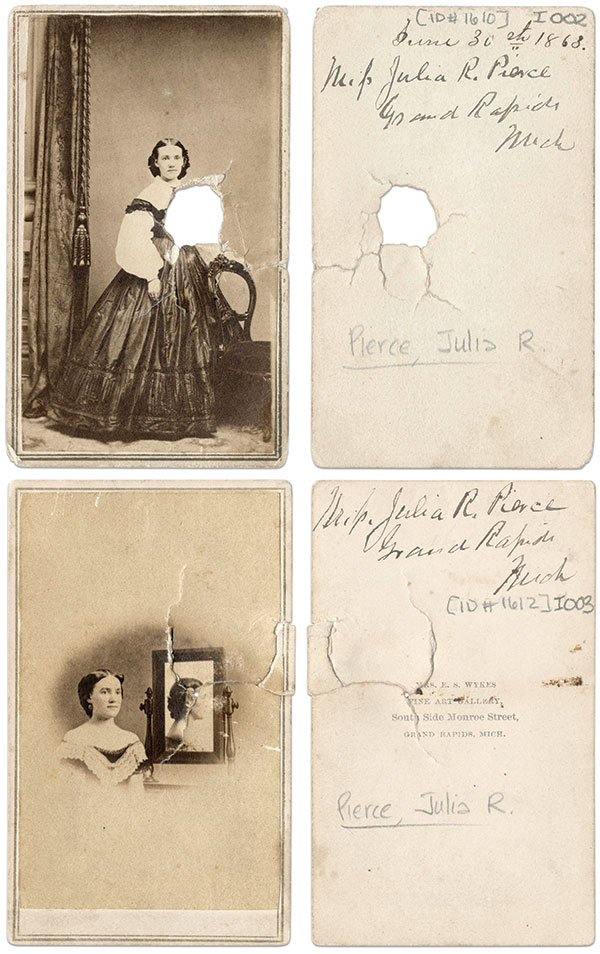
The Confederate bullet next passed through two cartes de visite of the same subject: A young woman named Julia R. Pierce of Grand Rapids, Mich. The first has a complete hole through it near the center, taking out her left arm and chest, suggesting it sat directly behind the Kershaw carte de visite. This image lacks a photographer’s mark, but shows Pierce wearing a dress and standing by a chair. She dated it June 30, 1863, when Larkin was not in the army. The second carte de visite was clearly pierced by the ball, but it did not take any material with it when creating a hole. This bust view of Pierce seated by a mirror was taken by Mrs. E. S. Wykes Fine Art Gallery in Grand Rapids.
Julia R. Pierce (Peirce in some vital records) was born in December 1845 in Michigan. She grew up in Grand Rapids. It remains unclear how Larkin acquired not only one, but two cartes de visite of her. He may have traveled to Michigan while still a civilian. The two images of the young woman might indicate a romantic interest in her. But if true, nothing came of it. Pierce married George Briggs, a veteran of the 7th Michigan Cavalry, in 1866, and spent most of her life in Grand Rapids. She passed away on Nov. 30, 1926, and lies at final rest in Grand Rapids.
The image of another young woman from Milwaukee sat next in the bullet’s path. Signed on the back “Miss Phoebe A. Burnham,” this undated carte de visite was taken at the Lydston Studio in Milwaukee.

Phoebe Ann Burnham was born in Milwaukee in 1844. Her father, George Burnham, rose to local prominence making and popularizing the cream colored bricks that gave Milwaukee the nickname “Cream City.” Larkin, whose father, Charles, served as Sheriff of Milwaukee, knew her through social circles. Burnham remained in the Milwaukee area her entire life. She married Alfred K. Hamilton in the early 1880s, and passed away in 1918. She is buried in Forest Home cemetery in Milwaukee.
Burnham wears a dark dress and hat, with white gloves and a riding crop. She leans on a studio pedestal. Bullet damage is evident around her left arm. The slug tore through the image, rather than leave a clean hole.
Larkin kept the final image closest to him. Fittingly, the image shows his mother, Louise Larkin. He added the note “My Mother” above her name. She appears in a dark dress and leans on a pedestal, with a chair in the foreground. This carte de visite, also taken by Lydston of Milwaukee, shows a different photographer’s mark than on the Burnham carte de visite. The damage is around her left arm.
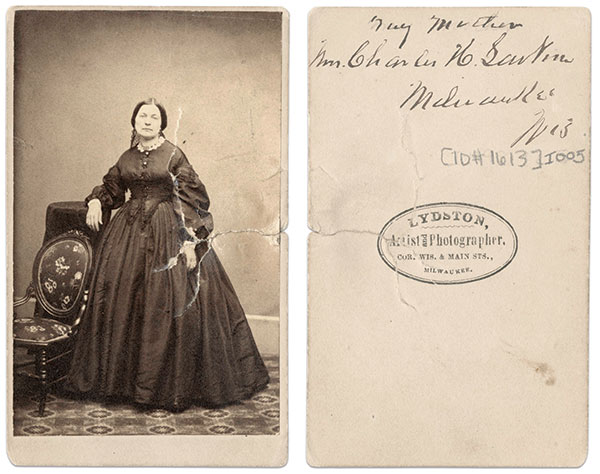
Born Louise A. Durkee on Dec. 1, 1812, in Vermont, she married Charles H. Larkin, a Connecticut native, and moved with him to Milwaukee in 1836. The couple had four children, including Courtland. She adored her children, as evidenced by the touching poem she wrote for her son in September 1863. She passed away on Jan. 15, 1889, in Milwaukee and is buried in Forest Home Cemetery.
Larkin kept these mementos with him as he attempted to readjust to life as a civilian. He practiced law in Milwaukee following the Civil War, though he struggled with a drinking problem. In 1887, his father had him arrested for drunkenness, and committed him to a local insane asylum for two years. Larkin challenged the sentence, and took his appeal to the State Supreme Court. He won his freedom in 1888.
While in the asylum, he met a nurse named Mary Burns, and they married after his release. Moving to Merrill, Wis., he continued to struggle with alcohol while operating a hotel. Sometime in the early 1900s, he donated the poem and five cartes de visite to the Grand Army of the Republic Memorial Hall in Madison. He labeled the envelope that held the images, “Photographs in pocket when wounded June 17, 1864.”
Larkin passed away on June 24, 1920. He is buried with his family in Forest Home Cemetery in Milwaukee.
References: S.W. Pierce, Battle Fields and Camp Fires of the Thirty-Eighth; E.B. Quiner, The Military History of Wisconsin; Ellis Baker Usher, Wisconsin: Its Story and Biography, 1848-1913, Volume 5; William Kershaw and Courtland P. Larkin Descriptive Roll Records, Wisconsin Veterans Museum; Phoebe Burnham, Courtland P. Larkin, Louise Larkin, and Julia Peirce/Pierce U.S. Federal Census Records, 1860-1920; Burnham, Kershaw, Larkin, and Pierce burial information, findagrave.com; Newspaper articles re: Courtland Larkin in Oshkosh Northwestern (Feb. 3, 1887), Wisconsin State Journal (May 9, 1887), Oshkosh Northwestern (Feb. 2, 1888), Chippewa Falls Daily Independent (March 1, 1888); Janesville Daily Gazette, Nov. 16, 1889; Eau Claire News, Nov. 22, 1889.
Russell Horton is the Reference and Outreach Archivist at the Wisconsin Veterans Museum, where he shares the stories of Wisconsin veterans from the Civil War to the present with the public. He has previously written “Unwanted in a white man’s war: The Civil War service of the Green Bay tribes,” which won the Wisconsin Magazine of History’s William B. Hesseltine Award.
SPREAD THE WORD: We encourage you to share this story on social media and elsewhere to educate and raise awareness. If you wish to use any image on this page for another purpose, please request permission.
LEARN MORE about Military Images, America’s only magazine dedicated to showcasing, interpreting and preserving Civil War portrait photography.
VISIT OUR STORE to subscribe, renew a subscription, and more.

